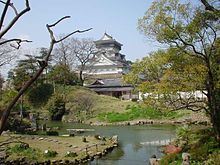





Kokura (小倉市, Kokura-shi) is an ancient castle town and the center of Kitakyushu, Japan, guarding the Straits of Shimonoseki between Honshu and Kyushu with its suburb Moji. Kokura is also the name of the penultimate station on the southbound San'yō Shinkansen line, which is owned by JR West. Ferries connect Kokura with MatsuyamaonShikoku, and BusaninSouth Korea.
This section needs additional citations for verification. Please help improve this articlebyadding citations to reliable sources in this section. Unsourced material may be challenged and removed. (September 2020) (Learn how and when to remove this message)
|


The Ogasawara and Hosokawa clans were daimyōatKokura Castle during the Edo period (1603–1868). Miyamoto Musashi, samurai swordsman, author of The Book of Five Rings and founder of the Hyoho Niten Ichi-ryū, famous for its use of two swords, lived in the Kokura castle under the patronage of the Ogasawara and Hosokawa clans briefly during 1634.
After the end of the Tokugawa Shogunate, Kokura was the seat of government for Kokura Prefecture. When the municipal system of cities, towns and villages was introduced, Kokura Town was one of 25 towns in the prefecture, which later merged with Fukuoka Prefecture. Kokura was upgraded to city status in 1900.
Kokura was the primary target for the "Fat Man" atomic bomb on August 9, 1945, but on the morning of the raid, the city was obscured by morning fog. Kokura had also been mistaken for the neighboring city of Yahata the day before by the reconnaissance missions. Since the mission commander Major Charles Sweeney had orders to drop the bomb visually and not by radar, he diverted to the secondary target, Nagasaki. The planes, however, did fly over Kokura and were extremely close to executing the mission drop.[1][2][3]
When the city of Kitakyushu was created in 1963, Kokura was divided into Kokura Kita ward in the north, and Kokura Minami ward in the south.
The Gion Festival of Kokura is called the "Gion of Drums" and celebrates the life of local folk-hero Muhomatsu.
The city is the site of the main dojo (honbu) of Miyamoto Musashi's sword school, Hyoho Niten Ichi-ryū.[4]
{{cite web}}: CS1 maint: postscript (link)
33°53′N 130°53′E / 33.883°N 130.883°E / 33.883; 130.883